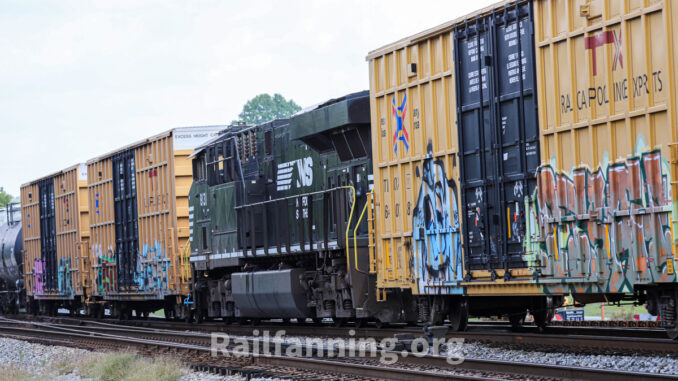
WASHINGTON — The heightened safety challenges and operational demands of long freight trains require coordinated actions from major freight railroad companies, the Federal Railroad Administration, and Congress.
That’s according to a new report from the National Academies of Sciences, Engineering, and Medicine. The study was undertaken by the Committee on the Impact of Trains Longer than 7,500 Feet and sponsored by the U.S. Department of Transportation.
In addition to evaluating safety, operations, and crew training issues for long trains, the report also examined their potential to block highway-rail grade crossings and interfere with Amtrak’s intercity passenger trains.
Complications of Long Manifest Trains
Driven by cost and efficiency considerations, freight railroads have operated increasingly longer manifest trains over the past two decades. Manifest trains haul freight in many different railcars with different weights and sizes. The number and mix of cars can add to the extreme forces that moving trains experience, which can stress equipment and create handling challenges for train crews, increasing the potential for derailments if not closely managed, the report says.
The report says there is no threshold at which a manifest train becomes a “long train” and is subject to greater safety concerns. Rather, as the length of the train increases, it becomes more important to manage in-train forces by placing additional locomotives in the train and assembling trains correctly.
Also, since manifest trains carry a mix of cargo, railcars of different types are picked up and dropped off en route, so a train’s handling demands can change over the course of a single trip.
“Freight railroads have provided such a dependable way to move goods and materials across the U.S. for so long that it’s easy to overlook them, but railroad operations have changed a great deal over the past few decades, as have the technologies used and our understanding of the best safety management practices,” Debra Miller, chair of the Kansas Turnpike Authority, and chair of the committee that wrote the report, said in an announcement. “So, the time is right for Congress, regulatory bodies, and the industry itself to take a closer look at railroad practices and regulations to ensure the safest operations going forward.”
Risk Reduction
Currently, the Federal Railroad Administration does not require railroad companies to target all major operational changes in their safety management systems. Instead, the agency requires only that railroads have “streamlined” risk reduction programs, which the report says raises questions about whether railroads are being sufficiently proactive and systematic in controlling the risks from longer trains, such as by using safe train-makeup practices and ensuring that crews are appropriately trained.
The report says that the FRA should strengthen the requirements so railroads can identify, analyze, and address the risks arising from all major operational changes, including using longer manifest trains. Railroads should also be required to regularly monitor and evaluate the effectiveness of these risk reduction measures and improve them as necessary.
Additionally, the FRA should seek resources from Congress to hire and train a team of auditors to critically assess all elements of each railroad’s risk reduction program and verify implementation.
Blocked Highway-Rail Grade Crossings
The report analyzes the issue of freight trains blocking roads at rail crossings, but did not reach conclusions about how longer trains are impacting the frequency and duration of blockages. Communities impacted by chronic crossing blockages point to train length as a factor, especially in areas where longer trains can extend beyond railyards to block multiple crossings on a regular basis, impeding access to neighborhoods, schools, and recreational facilities.
Congress should authorize and direct the FRA to obtain and publicly share data on blocked crossings, build a network-level understanding of the issue, and then negotiate with railroads to find solutions to the most problematic blockage sites, the report says. Congress should also empower the agency to impose financial penalties of sufficient magnitude to prompt good faith efforts to find solutions to this problem.
Amtrak Train Delays
Federal statutes grant Amtrak trains preference over freight trains — meaning that when there are track conflicts, freight trains must allow passenger trains to pass. The committee found that freight railroads do, nonetheless, run trains on routes where the train’s length exceeds the length of available sidings — where trains can briefly pull aside to clear the main track — preventing passing and causing Amtrak trains to be delayed behind slower freight trains.
The report recommends that Congress direct the FRA to monitor the performance of freight railroads to ensure Amtrak trains are being given preference. When an Amtrak train experiences delays because of an inability to meet or overtake a freight train, the freight railroad should be subject to financial penalties that are substantial enough to deter the practice and motivate solutions, such as rightsizing trains for the available infrastructure and investing in longer sidings.
Yard and Train Crews
In addition to having more demanding handling requirements, longer manifest trains can create challenges in maintaining radio contact over the length of the train, and the trains can take more time for railroad employees to assemble, disassemble, and inspect. For example, if a train stops because of mechanical or other issues, a crew member must walk the length of the train and manually set a sufficient number of handbrakes. It is unclear whether the freight railroads have done enough to prepare their employees for these added challenges, the report states.
The FRA should survey the railroad industry for best practices in ensuring appropriate and consistently applied train-makeup procedures, effective crew training protocols, and reliable communications systems for the safe operation of longer trains. Railroads can use this information in developing their risk reduction programs, and FRA auditors can use it for assessing the quality of those programs.

